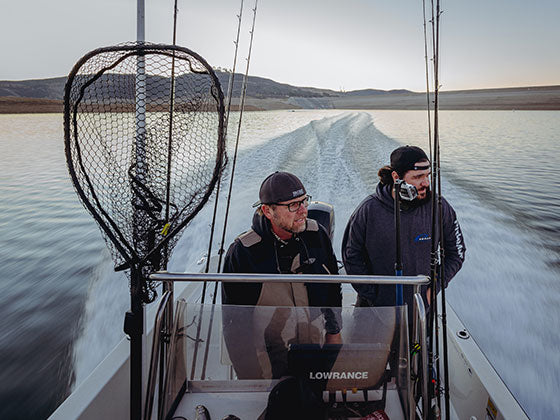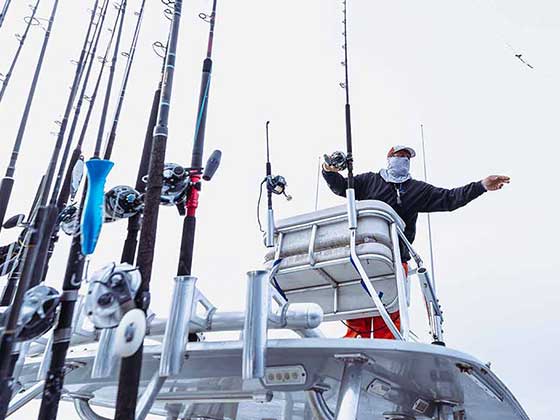A Buyer's Guide To Buying A Spinning Reel

Fishing rods and reels are like golf clubs, you generally need more than one to be proficient at either sport. Although you don't need as many rod combos as you do golf clubs, each rod and reel combination have specific uses that will make fishing more successful.
A spinning reel can be used with many applications from small fish like bluegill to giant tuna weighing over 100 pounds. Setting up your spinning reel with the right line and rod are crucial to making sure you have a successful trip. The line size is critical for the spinning reel you choose and the type of fish you plan on targeting.
Spinning rods and conventional or bait casting rods are different so make sure you have the right rod for your reel. In general, the spinning rod has a larger first guide, which is the guide closest to the reel.

We call out for monofilament line or fluorocarbon line on the reels but braided line, aka spectra line, is ideal choice for spinning reels. With braided line, there is virtually no memory or coiling, it lasts for years without deteriorating, and the leader can be changed with a simple connection knot.
If you plan on using braided line, use the stated line ratings in this article for your leader size. Braided line is much thinner, so in general increase the braid size by approximately 3 x’s the size of your leader. For example, if you fish a 10lb leader, use 30lb braided line.
Smaller Fish:
If you are targeting smaller fish, a 500 to 1000 size reel would be best. If your reel is too big for your line size, you'll have more line than you need and your casting distance will be impaired. You probably don't need 400 yards of 6lb line for catching trout but we see it all the time in the shop. Customers will bring in a 3000 size reel and ask for 6lb line. A 500 to 1000 size reel would be better suited.
500 Size Reel:
For 2-4 pound monofilament (mono) or fluorocarbon (fluoro) line, this is the size reel you want. The Shimano Nasci or Shimano Sahara would be a good choice in this size range. We would pair it with an ultralight rod from 5 to 8 feet depending on the application. When fishing streams you'll be able to navigate branches and bushes better with a shorter rod, around 5 to 6 feet.
For rivers or lakes, a 7 to 9 foot rod would be best for longer distance casting. Just make sure the rod is rated to the lure size and line size you are using.
1000 Size Reel:
Best used with 4-8 pound line, the 1000 size works best when fishing for bass, walleye, or medium size trout. A good budget reel is the Daiwa Ballistic or the Abu Garcia President. Although there is no industry standard for the numbering system on reels, it can be confusing looking at the Abu Garcia 2000 size reels, they are the same size as other manufacturers 1000 size reels. Ultimately you have to look at how much line each one holds.
For vertical bass fishing or drop shot techniques, we suggest a 6 foot 8 inch rod with a light action but a 7 foot rod works fine too. When long distance casting is needed, a 7' 6" to a 9 foot rod will do the trick. An example of rod ratings to look for is 6-12lb line - 1/4oz to 1/2oz - with a medium fast action.
Medium Size Fish:
When your line size goes up, so does the reel size and the rod ratings. A larger diameter and deeper spool allows for the use of larger line.
2500-3000 Size Reel:
When you need to jump your line size up to 6-15lb line your reel size should be bigger too. The length of the rod doesn't necessarily change just because you went up a reel size or two. The rod needs to have higher ratings so that the it matches the lure size and line you are now using.
Shimano makes two Stradic reels, the Ci4 is made of carbon and the FJ is made of aluminum. The lighter Ci4 is great when weight is a concern and torque and power are less important. The carbon material flexes more so it's not great for stronger fish, but the Stradic FJ is more rigid and better for harder fighting varieties.
4000-6000 Size Reel:
The 4000 size isn’t too big but the 6000 size is starting to bulk up a little and starts to get heavier. A heavier reel means fatigue for the angler when fished for long periods of time.
Each reel should state the recommended line sizes on the spool, but generally medium size reels will use 10-17lb mono or fluoro line. Just make sure the reel seat on the rod you choose will accommodate the bigger foot on the reel.
The Shimano Thunnus Ci4 is a killer reel and comes with the added bonus of a baitrunner feature. It's made of reinforced carbon so it's light, the baitrunner feature disengages the spool so your bait can run uninterrupted. When you get bit simply turn the handle and the spool is reengaged with your preset drag amount.
Note: Some more expensive reels are made with carbon making them lighter for their size. They also have more bearings and better components giving them greater longevity. Having more bearings supports the internals of the reel better so flexing is decreased and torque/power is increased. The better reels also have more durable gears with more refined teeth on on the gear, allowing you to catch bigger fish without failure.Larger Fish:
8000-10000 Size Reel:
Now we are getting into some bigger reels that are designed for bigger line in the 20-30lb class. Keep in mind, these are big reels that are designed for big fish. Often times newer anglers think they are saltwater fishing and a bigger reel is necessary.
This often isn’t the case as most of the fish close to shore are smaller. Just make sure you match the reel and rod size to the size of fish you are targeting and not to the bigger fish you might accidentally catch.
As always, make sure the rod matches the reel you select. A longer rod with a lighter tip will allow for better casting. A light tip and stiff backbone generally makes a great rod even on bigger fish.
Penn makes great reels in this size and the more expensive flavors will hold up to a lifetime of abuse. The Penn Battle 2 is a great budget reel but the Penn Slammer 3 is top of the line and is fully sealed.
14000-30000 Size Reel:
Now we’re getting serious! These reels are no joke and are for the serious angler who wants to catch really big fish! We are talking 20-60lb mono or fluoro line and a high end rod to match. Don’t go cheap when you are at the point you need a rod or reel this big. See the guys or gals at your local tackle shop and make sure you are setup properly. If you are in the area, come by and see us at Tackle Express and we'd be glad to help.
Taking these factors into consideration on your next trip will help ensure your success and comfortability.





